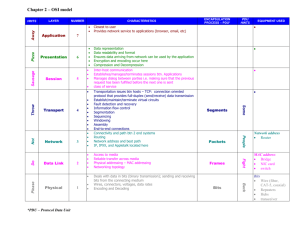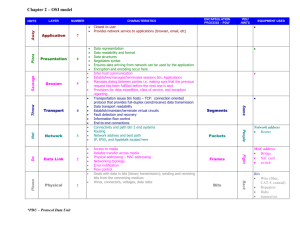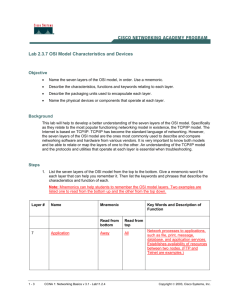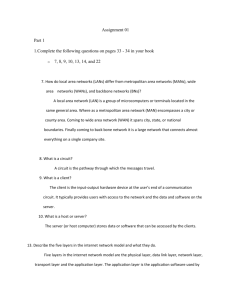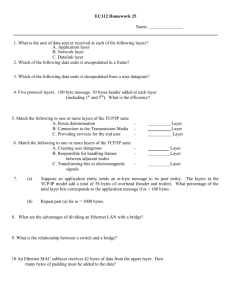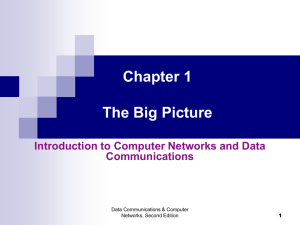TCP/IP & OSI Model Homework Assignment
advertisement
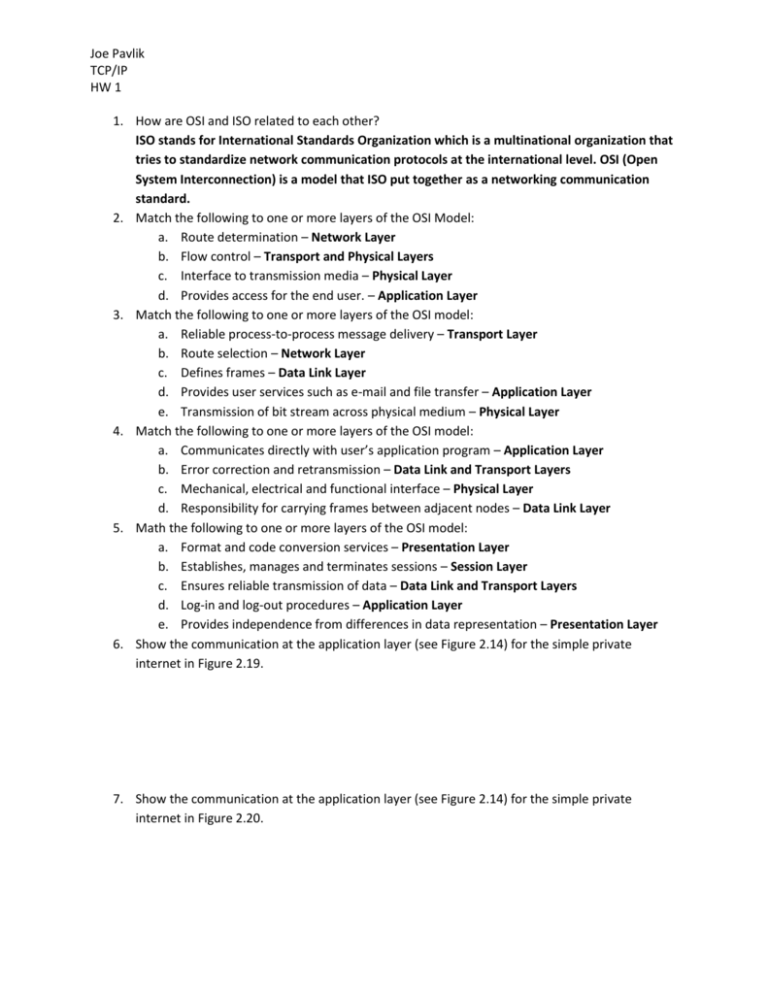
Joe Pavlik TCP/IP HW 1 1. How are OSI and ISO related to each other? ISO stands for International Standards Organization which is a multinational organization that tries to standardize network communication protocols at the international level. OSI (Open System Interconnection) is a model that ISO put together as a networking communication standard. 2. Match the following to one or more layers of the OSI Model: a. Route determination – Network Layer b. Flow control – Transport and Physical Layers c. Interface to transmission media – Physical Layer d. Provides access for the end user. – Application Layer 3. Match the following to one or more layers of the OSI model: a. Reliable process-to-process message delivery – Transport Layer b. Route selection – Network Layer c. Defines frames – Data Link Layer d. Provides user services such as e-mail and file transfer – Application Layer e. Transmission of bit stream across physical medium – Physical Layer 4. Match the following to one or more layers of the OSI model: a. Communicates directly with user’s application program – Application Layer b. Error correction and retransmission – Data Link and Transport Layers c. Mechanical, electrical and functional interface – Physical Layer d. Responsibility for carrying frames between adjacent nodes – Data Link Layer 5. Math the following to one or more layers of the OSI model: a. Format and code conversion services – Presentation Layer b. Establishes, manages and terminates sessions – Session Layer c. Ensures reliable transmission of data – Data Link and Transport Layers d. Log-in and log-out procedures – Application Layer e. Provides independence from differences in data representation – Presentation Layer 6. Show the communication at the application layer (see Figure 2.14) for the simple private internet in Figure 2.19. 7. Show the communication at the application layer (see Figure 2.14) for the simple private internet in Figure 2.20. Joe Pavlik TCP/IP HW 1 8. A 100-byte message is sent through a private internet using the TCP/IP protocol suite. If the protocol adds a 10-byte header at each layer, what is the efficiency of the system (the ratio of the number of useful bytes to the number of total bytes)? 5 Layers adds 50 bytes for a total of 150 bytes. Ratio is 100/150 or 2/3 or roughly 66%. 9. If a port number is 16 bits (2 bytes), what is the minimum header size at transport layer of the TCP/IP protocol suite? 32 bits 10. If a logical address is 32 bits (4 bytes) what is the minimum header size at network layer of the TCP/IP protocol suite? 64 bits 11. If a physical address is 48 bits (6 bytes) what is the minimum header size at the data link layer of the TCP/IP protocol suite? 96 bits 12. Do we encapsulate our message when we send a regular letter to a friend? When we send a post card to a friend while we are vacationing in another country do we encapsulate our message? Yes we do encapsulate our message when we send a regular letter. We place the letter in an envelope with a destination address and a return address (headers). The Post Office then takes our letter, adds more addresses (headers) and sends on its way. Once it gets to the destination post office, it is then sent to the address we specified. This is also true of international postcards except they add yet another layer of addressing (headers). 13. Why do you think that we do not need addresses at the physical layer? We do not need addresses at the physical level because the physical layer deals primarily with hardware and physical connections. 14. Why do you think a radio station does not need the addresses of its listeners when a message is broadcast? The radio station does not need to connect to the listener. It is broadcasting and allows any listener to grab the signal without requiring any information in return. Its intention is to deliver the message to every listener that can access the broadcast signal. 15. Why do you think both the sender and receiver addresses are needed in the Internet? Both the sender and receiver are needed in the Internet because specific information needs to be sent from one device to another without being lost or delayed. The addresses tell the network devices where to send the data. Using the letter example above, a mailman would not want to knock on every door to see if the letter was for that person. Instead, they will know exactly what house to bring the letter to. 16. Why do you think there is a need for four levels of addresses in the internet, but only one level of addresses (telephone numbers) in a telephone network? The telephone network has one level of addresses because it is generally one-to-one communication and doesn’t contain multiple layers. A connection is made and all data is transferred across the one layer. On the internet, multiple layers communicate with each other thus needing multiple levels of addresses.

